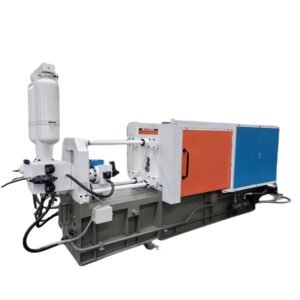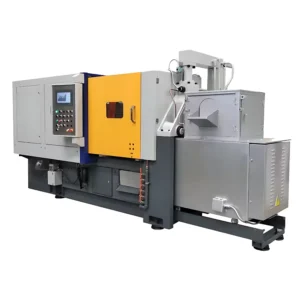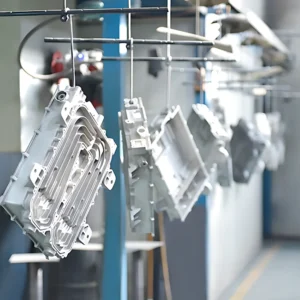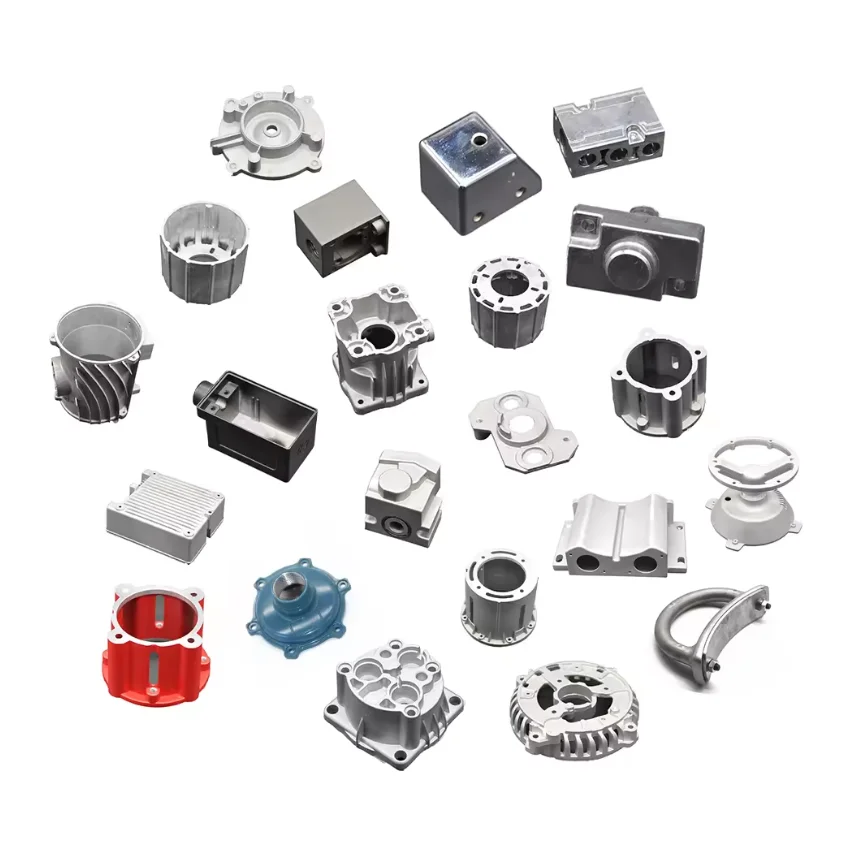What is Die Casting?
Die casting is a metal casting process that injects liquid metal into a mold cavity under high pressure and high speed, usually using low melting point alloys. This method can produce complex metal parts with high precision, good surface quality, and high strength. It can produce large quantities of parts with stable quality and is widely used in various industries such as automotive, aerospace, and electronics.
Related read: What is Aluminum Die Casting?
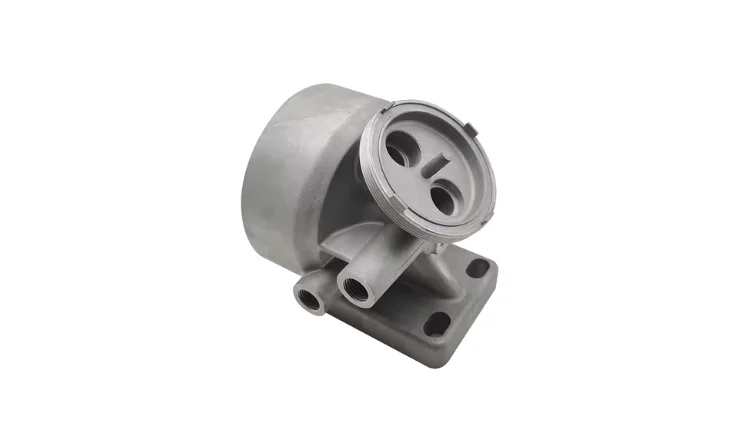
Types of Die Casting
There are many types of die casting, each with its unique advantages. The two most common types of die casting are cold chamber die casting and hot chamber die casting.
Hot Chamber Die Casting
Hot chamber die casting, also known as gooseneck casting, is suitable for low melting point metals such as zinc, tin, and lead. In this process, the metal is melted in a furnace connected to the casting machine. The molten metal is then injected into the mold cavity at high speed and high pressure.
This method can achieve filling speeds of up to 540 km/h and pressures of 150 to 1200 bar. It can achieve fast cycles, about 15 cycles per minute. The productivity is high, but it is not suitable for high melting point metals such as aluminum, and there is a risk of damaging machine parts.

Cold Chamber Die Casting
Cold chamber die casting is used for high melting point metals such as aluminum and copper. The metal is melted in a separate furnace and then poured into a casting machine, which injects the molten metal into the mold at high temperatures.
Pressures range from 2000 to 20,000 PSI. The process is slower than hot chamber die casting but can produce larger and more durable parts, making it ideal for the automotive and aerospace industries.
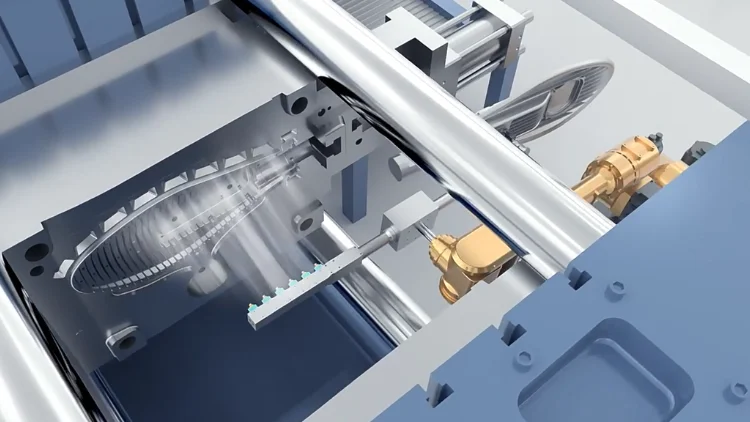
Low-pressure Die Casting
Low-pressure die casting involves injecting molten metal into a mold cavity at low pressure (usually about 0.08 to 0.1 MPa).
This method reduces air entrapment, producing higher-quality parts with less porosity. It is often used to produce large parts with simple geometries. , such as automotive wheels and engine blocks.
High-pressure Die Casting
High-pressure die casting forces molten metal into the mold cavity at very high pressures (1500 to 25,000 PSI). This method can produce complex parts with thin walls (usually less than 3 mm thick). Mass production of components that require high dimensional accuracy and smooth surface finish.
Gravity Die Casting
Gravity die casting uses gravity to fill the molten metal into the mold. This method is simpler and less expensive than pressure die casting, so it is suitable for small batch production and parts with thicker cross-sections. It is often used for automotive components such as cylinder heads and transmission housings.

Vacuum Die Casting
In vacuum die casting, a vacuum is applied to the mold cavity to draw in the molten metal, minimizing air entrapment and porosity. The process produces parts with excellent surface quality and mechanical properties, making them suitable for high-strength and high-integrity components. Commonly used in the automotive and aerospace industries.
Squeeze Die Casting
Squeeze die casting involves filling the mold with molten metal and then applying additional pressure of up to 140 MPa to squeeze the metal into a smaller cavity. This method reduces porosity and improves mechanical properties, making it ideal for high-strength applications such as automotive suspension components and steering knuckles.
Semi-solid Die Casting
Semi-solid die casting, also known as thermoforming, uses semi-solid metal alloys to produce parts with high dimensional accuracy and minimal porosity. The process is particularly suitable for complex shapes and is used in applications that require tight tolerances, such as electronic housings and transmission components.
These different types of die-casting processes have unique advantages and are selected based on the specific requirements of the part being produced, including material, geometry, and production volume.
Advantages and Disadvantages of Die Casting
Advantages
- Fast speed and high output: Die casting can produce a large number of parts quickly due to its automated nature, making it suitable for large-scale production.
- Precision and consistency: It can create complex shapes with high precision, often without the need for secondary operations. Each part produced is almost identical, which reduces the defect rate.
- Cost-effective: Although the initial setup cost is high, the high production speed and minimal need for secondary operations can significantly reduce costs for large-scale production.
- Strength and durability: Die castings are dense and strong, with excellent mechanical properties. When non-ferrous metals such as aluminum, zinc, and copper alloys are used, they have good corrosion resistance.
- Smooth surface finish: Parts produced by die casting have a smooth surface, reducing the need for post-processing.
Disadvantages
- High initial cost: Die casting has high setup and tooling costs, which may be unaffordable for small-scale production.
- Not suitable for small-scale production: Due to the high initial cost, die casting is not cost-effective for small-scale production.
- Porosity issues: Rapid cooling and solidification can cause porosity in the casting, affecting its strength and durability.
- Limited material selection: Die casting is generally limited to nonferrous metals and excludes many high-melting-point alloys.
Die Casting Applications
Die casting is used in a wide range of industries because of its ability to produce high-precision and high-strength parts. Common applications include:
- Automotive: engine blocks, transmission cases, wheels, and other key components.
- Consumer Electronics: housings, connectors, and frames for smartphones and other devices.
- Aerospace: actuators, engine mounts, and other high-strength components.
- Industrial Machinery: pumps, valves, and various mechanical parts.
What is Die Casting Process?
Die casting is a manufacturing process in which molten metal is injected into a mold to create complex and precise metal parts. The process begins with a preparation stage where the mold is carefully designed and manufactured. Let’s dive into the detailed steps of the die casting process, starting with the preparation of the mold.
Preparation
The preparation phase begins with making and preparing the mold. The mold is usually made of hardened steel to withstand high temperatures and pressures. The mold design begins with a CAD (computer-aided design) drawing. This file is used to manufacture the mold using CNC (computer numerical control) machining.
Once the mold is made, it is prepared with a release agent or lubricant to prevent the molten metal from sticking. Depending on the metal and the complexity of the part, the mold can be preheated to improve the flow of the molten metal and reduce thermal shock.
Injection
During the injection phase, the metal alloy is melted into a liquid state. For hot chamber die casting, the metal is melted in a furnace attached to the machine, maintained at a temperature suitable for metals such as zinc and magnesium, which melt at lower temperatures (370°C to 420°C).
In cold chamber die casting, the metal is melted in a separate furnace and then poured into the die casting chamber. This method is suitable for metals with higher melting points (660°C), such as aluminum.
The molten metal is then injected into the mold cavity under high pressure, ranging from 150 to 1200 bar (2175 to 17,405 psi) at speeds of up to 540 km/h (335 mph). This high-pressure injection ensures that the metal fills the smallest locations in the mold.
As discussed in the article Die Casting vs Injection Molding, this process is crucial for achieving precision in complex parts.
Cooling
After the molten metal is injected into the mold, it begins to cool and solidify. The cooling time depends on the type of metal, the size, and the complexity of the part. Typically, aluminum parts may take a few seconds to solidify, while larger or more complex parts may take longer.
Maintaining pressure during the cooling process minimizes porosity and ensures the dimensional accuracy of the part. The mold surface quickly conducts heat away from the molten metal, causing it to solidify within the mold.
Ejection
After the metal has completely solidified, the mold halves separate. Ejector pins can push the solidified part out of the mold. Using ejector pins ensures that the part can be removed without damaging its intricate details. The ejection stage must be carefully controlled to prevent the part from being deformed or damaged.
Finishing
The final step in the die-casting process is finishing. This involves removing excess material formed during the injection process, such as gates, runners, and flash. Trimming can be done with a saw, trimming die, or other cutting tool. Make sure the part is free of any unnecessary protrusions and meets the part’s standard specifications. Trimmed material is often recycled back into the process.
Summary
Die casting has the advantage of faster production, fewer secondary operations, and lower unit costs when produced in large quantities, making it the preferred choice for industries requiring large quantities of precision parts. China Casting Synergy Group, with over 20 years of manufacturing expertise, is committed to providing the highest quality products at competitive prices.
Let us help you improve productivity and cost-effectiveness through our specialized die casting services.

